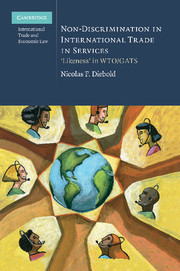Book contents
- Frontmatter
- Contents
- Foreword
- Acknowledgements
- Abbreviations
- List of Cases
- List of Legal Texts
- List of Documents
- Introduction
- PART I Foundations
- PART II Framing the conceptual breadth of ‘likeness’ in GATS
- 5 ‘Likeness’ in national treatment
- 6 ‘Likeness’ in MFN treatment
- 7 Comparative analysis of ‘likeness’
- 8 Concluding summary: economic standard
- PART III GATS specific ‘likeness’ issues
- PART IV Methodology for the ‘likeness’ analysis in GATS
- Bibliography
- Index
5 - ‘Likeness’ in national treatment
Published online by Cambridge University Press: 10 January 2011
- Frontmatter
- Contents
- Foreword
- Acknowledgements
- Abbreviations
- List of Cases
- List of Legal Texts
- List of Documents
- Introduction
- PART I Foundations
- PART II Framing the conceptual breadth of ‘likeness’ in GATS
- 5 ‘Likeness’ in national treatment
- 6 ‘Likeness’ in MFN treatment
- 7 Comparative analysis of ‘likeness’
- 8 Concluding summary: economic standard
- PART III GATS specific ‘likeness’ issues
- PART IV Methodology for the ‘likeness’ analysis in GATS
- Bibliography
- Index
Summary
During the Uruguay Round, the negotiators specifically pointed out that Article III GATT ‘had been set up for products, not for producers (or activities), and it was therefore difficult to see how it could be applied to services, the imports of which were not covered by customs duties at the border as was the case with trade in goods’. Due to the potentially very broad implications of a national treatment obligation for services, the negotiators even argued that ‘[i]n the context of trade in services, national treatment should thus be seen only as a yardstick and not as a basic obligation’. Despite these prior reservations, the negotiators recognized the importance of including basic GATT principles into GATS, including the national treatment obligation. Under GATS, the national treatment obligation is set forth in Article XVII, which states as follows:
‘1. In the sectors inscribed in its Schedule, and subject to any conditions and qualifications set out therein, each Member shall accord to services and service suppliers of any other Member, in respect of all measures affecting the supply of services, treatment no less favourable than that it accords to its own like services and service suppliers.’
Even though the GATT and GATS provisions on national treatment embody the same basic principle of non-discrimination, there are a number of differences between the two agreements that must be taken into consideration in a comparative analysis.
- Type
- Chapter
- Information
- Non-Discrimination in International Trade in Services‘Likeness' in WTO/GATS, pp. 103 - 126Publisher: Cambridge University PressPrint publication year: 2010

